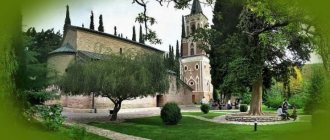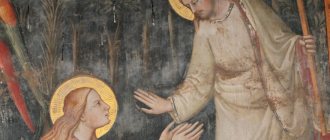In the life of Valentina Minskaya we learn that she was born into the family of a famous priest
Valentina's father, Feodor Iosifovich, is a priest from the famous priestly family of Chernyavsky. Father Theodore graduated from the Minsk Theological Seminary in 1873. He was ordained to the priesthood by the Bishop of Minsk and Bobruisk, His Eminence Alexander.
After Theodore accepted the rank of priest, he served first in the church in the village of Kochanovichi, then in the village of Dostoevo.
In 1890 he was commended for his service. From 1902 to 1904 he served as dean in the village of Stankovo. He was awarded the pectoral cross and received the Order of St. Anne, 3rd degree. At this time he also fell ill at the Stankovsky School.
In 1888, Father Theodore himself built a house for his family. And then the St. Anin Church was built in the village of Koski.
Valentina's mother, Sofya Petrovna Chernyavskaya, was a very strict woman. Before the birth of her last daughter, Valentina, she had already raised 3 daughters: Anna, the eldest, Ksenia and Olga.
April 7, 1888
Valentina's birthday
Valentina was born on April 7, 1888. She was baptized in St. Nicholas Church. All the girls were friendly with each other and never fought. Their childhood passed quite quietly and peacefully against the backdrop of beautiful rural landscapes.
Once, when she was still little, Valentina planted a small Christmas tree near the temple. She constantly looked after it, watered it and prayed to God that her tree would grow strong and big. To the surprise of many, the Christmas tree grew in the shape of a cross. Such a surprisingly strange event happened in Valentina’s life.
Having become an adult, Valentina, like her father, began to study at the Minsk Theological School. After graduating from college, she sometimes taught lessons in the Law of God at the Public School in her father’s place.
Even in her youth, the girl was awarded the great honor of talking with John of Kronstadt himself.
Valentina and her relatives very quickly lose their husbands - they end up under arrest in those years
In 1930, the collective farm “Awakening” was created. During the period of collectivization, Sulkowski also had to enroll in the collective farm.
Soon after this, carts walked through the village, collecting their harvest from all the peasants.
With the advent of such complete lawlessness, people begin to be arrested.
1933
in April of this year, Valentina has to say goodbye to her husband forever
Valentina's husband also falls under this arrest by mistake. He is sent to a camp, where he remains until April 1933.
Soon Theodore receives permission to be released and sent to Astrakhan. There he is arrested again, after which he is sent to the Far East, where he dies.
At the same time, other relatives of Valentina were also injured. Sister Anna’s husband, priest Vasily Stepura, was also arrested and exiled to Kazakhstan for three years.
Sister Ksenia’s husband, priest Sergius Rodakovsky, was sentenced to death.
Sergius Rodakovsky in 1999 was glorified among the holy new martyrs and confessors of the Minsk diocese.
Sergius Rodakovsky was glorified with the rank of martyr
Valentina was left without a husband. She begins to care for her mother, who was very ill.
All this greatly undermines the health of Valentina herself.
Valentina visited a sick woman who had been in bed for more than 40 years and she told her: “You will soon replace me.”
One day Valentina comes to see a woman who has been ill for a long time. She lay motionless for about forty years. She told Valentina, “You will soon take my place.” After this, another incident occurred that changed Valentina’s life forever.
Life tests
She grew up in a Belarusian village, located in a picturesque place next to a river, in a spiritual, prayerful atmosphere with three other sisters.
They were raised as future mothers, taught prayers, obedience, and housekeeping. But the cruel time that crushed the fates of millions of people did not spare either Valentina Feodorovna or her family.
Her husband was exiled and died in the camp. She lost almost all her relatives and friends, since most of them belonged to the clergy and were exiled or shot. Her health, destroyed by a difficult life full of trials and cruel losses, completely left her, she fell ill.
Until 1937 she lived with her mother Sophia. Priests often came to their house for secret services. Even then, her fellow villagers considered her a saint. Soon, in 1939, the last functioning church in Minsk closed.
Valentina’s second incident at the stream radically changed her future life
One day Valentina went to the stream to wash her feet, suddenly she saw an amazingly beautiful woman. She told her, “Go and lie down.” Valentina did as the woman told her. She lay down and could no longer get up.
She spent 33 years in her bed until her death.
Surprisingly, for the rest of her bedridden life, she had no congestion or bedsores, as usually happens in such patients
The nephew of Valentina’s husband, Alexander Alexandrovich Sulkowski, showed great concern. Every month, together with his wife, he sent 100 rubles by postal order to Valentina’s family.
Mother Valentina collected all the coupons with these transfers, as a visual memory of how her husband’s family helped her during that most difficult time for them. Her sisters, who were also widowed, also helped as best they could.
1937
Valentina's mother died earlier this year
Valentina is completely orphaned. Her neighbors took care of her.
Valentina had to endure many things: the death of her husband, the death of her mother, as well as the death of many clergy of the Minsk Diocese.
But all these painful trials only strengthened her, and she took upon herself the feat of blessed service to God.
Soon many miracles began to happen. She predicted the First World War, saying: “We will have to see iron cannons...”.
During the war, wives came to her, sisters of men who were sent to the front to fight. They brought her scarves, which mother blessed and that was the only way everyone knew that their husbands would return home. And in fact they were returning.
Valentina lived the last year of her life with her sister Olga.
Valentina lived very modestly, lying on a small, modest bed. She also ate very little and also modestly.
Even the people who brought her food, she did not eat, saying: “You eat, and it’s easier for us who are sick to lie down.”
She gave advice to people who had not yet had time to ask their question.
2006
Blessed Valentina Canonized
Valentina died on February 6, 1966. Her grave is located in the rural cemetery of the village of Krysovo, Dzerzhinsky district, Minsk region.
Curriculum Vitae
Valentina Feodorovna Chernyavskaya was born on April 7, 1888. Her home village of Koski is located thirty-eight kilometers from Minsk.
Origin
The blessed one's father, Theodore Cherniavsky, was a clergyman. He was in charge of the parish of St. Nicholas Church in the neighboring village of Stankovo. Valentina's mother is Sofya Petrovna Svirskaya, bearer of the princely surname, an intelligent and educated woman.
Life
Valentina spent her childhood in her parents' house. She had three sisters. The mother raised her daughters according to the rules of piety and severity.
Basic facts of the worldly life of Blessed Valentina:
- studied at the Minsk Theological Women's School with her sisters;
- married Feodor Sulkowski, a collegiate adviser to the Minsk district administration;
- during the First World War she took typing courses and worked at the front as a typist;
- after the war, she and her husband ran their own household;
- in 1931 she lost her husband: Feodor Sulkowski came under repression as he came from a family of priests and was sent into exile. The husbands of Valentina's two sisters were also arrested and exiled, since they were clergy. None of them returned from the camps;
- survived the death of her father, who was seriously ill in recent years, but continued to lead services in the temple. Soon the mother also passed away;
- The year 1937 was marked by a new tragedy: all the clergy who remained in the Minsk diocese were shot. Among them were Valentina's last friends;
- After the confiscation of her parents' house, she lost her home and was forced to live in a church gatehouse.
In a cold room with an earthen floor, Valentina felt sick. Even before the death of her mother, the saint suffered from inflammation of the kidneys and lay in bed for a long time.
Valentina was helped by her husband's nephew. Alexander Sulkowski sent the saint a small amount of money every month. The woman gratefully kept the money transfer receipts until the end of her life. Valentina was also helped by her younger sister Olga. She did not marry, worked as the head of a Minsk school and sometimes gave the last of her funds to the sick.
Olga found the best refuge for Valentina - the house of neighbors Anton and Efrosinya Loiko, where the saint lived for the remaining thirty-three years.
Demise
Valentina spent many years bedridden, but not inactive. Blessed Xenia of Petersburg appeared to the saint in a dream and blessed him to serve God. Soon Valentina discovered the gift of foresight and healing.
As Matrona of Moscow, the woman was immobilized, but she saw with her inner gaze the events taking place far from her. And, like Ksenia of St. Petersburg, Blessed Minsk spoke in encrypted phrases that concealed deep meaning for those who knew how to listen.
Valentina perceives illness as God’s instruction to call for repentance, pray and give thanks for the suffering and mourning.
On February 6, 1966, the earthly journey of Valentina Sulkowskaya, née Chernyavskaya, ended. But the spiritual life of Blessed Valentina Minsk continued and will be eternal in the memory of people.
Every day a lot of people gather at the grave of St. Valentine - asking for help
Now you can find huge crowds rushing to mother’s grave.
If they ask local villagers how to get to the cemetery, everyone already knows that they are going to Mother Valentina.
There are quite a lot of people at the grave every day. People come to ask Saint Valentine for help
The current priest, Father Alexander, calls the road through the village to the cemetery a procession of the cross.
People come to mother’s grave with their prayers and requests. There are many stories of miraculous healing.
Anna Vasilievna Skryabina talks about one of the miraculous healings:
“My leg hurt for a long time.
At night I always put a compress on it and bandaged it with an elastic bandage and only then could I walk.
And so we came to mother, kissed each other, and prayed.
I came home, washed my leg in the evening, but forgot to tie it again.
I only remembered this in the morning, I get up and think, what am I doing now, now my leg will swell and I won’t be able to walk.
But! Imagine, until today I never thought about her again!”
Location of the relics
The grave of Valentina Minskaya is located in the cemetery of the village of Krysovo, Dzerzhinsky district, Minsk region. The burial took place without a funeral service due to an anti-church ban. But the priest, dressed in civilian clothes, was quietly present among the large crowd of people wishing to say goodbye to the healer. At first, an ordinary cross and a fence were placed on the saint’s grave. Now it has a metal canopy or canopy, decorated with a forged vine, a dome and a cross.
The grave of Valentina Minskaya has historical and cultural significance. Therefore, it is not possible to transfer the saint’s relics to the capital. But the flow of believers does not stop. After all, before her death, the blessed one called to come to her for help, as if she were alive.
Valentina Minskaya helps in improving health
How does the saint help? What do they pray to her icon for?
The saint helps:
- in promoting human health;
- in salvation from obsession;
- in strengthening a person’s faith;
- in helping with various diseases.
Usually they come to mother and ask for anything. The main thing is to ask it sincerely, and she will always help.
Anyone who wants to pray to Saint Valentine can buy her icon in any Orthodox church for their home
There is a special prayer that must be read every day in front of the icon:
O our blessed mother Valentino! Just as in the days of your earthly life, you received with love all the suffering and infirm,
everyone in sorrow and illness, and with your prayers you healed their ailments.
Likewise now to all who come to you with faith and tenderness,
ask the Lord for healing,
Most of all, save us from the falls of sin and guide us on the path of salvation.
Hear us unworthy, blessed Valentino,
and bring our prayers to the Throne of the Most High,
let us joyfully praise the Most Holy Trinity:
Father and Son and Holy Spirit, now and ever and unto ages of ages. Amen.
What not to do on February 6
The saint's memorial day is also called Aksinya's day, on which in the old days many restrictions were in force. In particular, on February 6, it was forbidden to cut nails or hair, make the bed, wash or clean the house, since all these actions could lead to illness.
Also on this day, they tried to refrain from tying knots, so as not to confuse their own fate, and did not tell anyone their dreams. It was believed that a good dream in this case might not come true or might come true in a completely different way, but a bad dream, if told about it, would definitely come true.
You can get to the grave by personal transport or by train.
How to get to my mother's grave? If you drive by car, the route will be as follows: if you drive from Minsk, then the cemetery where the blessed one is buried is on the right side.
Approximately 1.5 km after the overpass above the highway with the sign “Stankovo”. There will be signs at the cemetery, right up to the grave.
If you drive from Dzerzhinsk, then the cemetery is to the left of the highway 3 km after the overpass near the villages of Tsvetkovo-Kukshevichi.
If you go by train, you will have the following route: we get to Minsk, to the Pyatigorye station. Next you need to go past the holiday village, a small forest, the village of Krysovo to the local cemetery.
There will be signs indicating exactly where the grave is located. In any case, you can ask the local residents, they will always help.
They always bring a lot of flowers to mother’s grave
Holy Blessed Valentine pray to God for us!
By leaving a comment, you accept the user agreement
Iconography
Blessed Valentina of Minsk is depicted according to the traditions of the Orthodox Church:
- on a gold background;
- with a halo;
- in olive, blue clothes;
- in a white or blue headscarf;
- with an open left palm;
- with a palm branch in the right.
The blue color symbolizes holiness, and the white color symbolizes the purity of the soul. Blessed Valentina is the most revered saint in Belarus, along with Bishop Kirill of Turov and the blessed princess Euphrosyne of Polotsk. Their common icon was developed by the icon painters the Zharov brothers.
Behind the backs of the saints rises the main temple of Minsk - the Holy Spirit Cathedral. The central figure of the icon is the Bishop of Turov. On the right is Valentina Minskaya wearing a green cloak over a white long shirt and a white namitka, the national Belarusian headdress. The blessed one wore a namitka in life, so the scarf was made a traditional element of her iconographic image.









